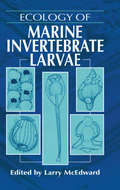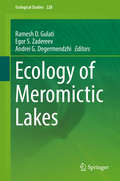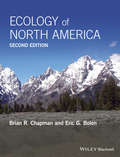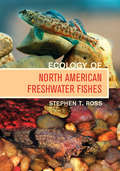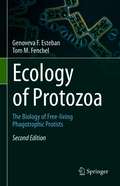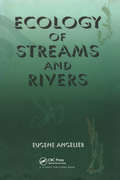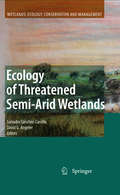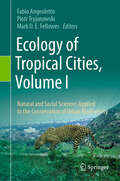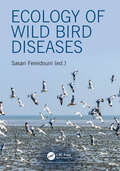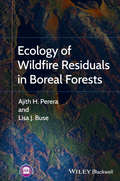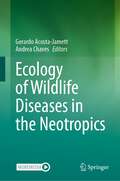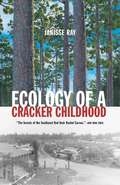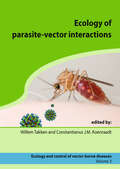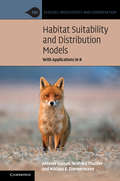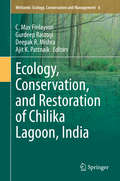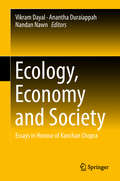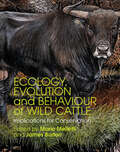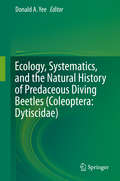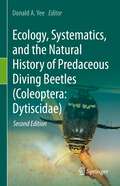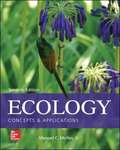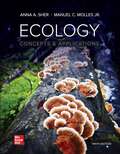- Table View
- List View
Ecology of Marine Invertebrate Larvae (Crc Marine Science Ser. #6)
by Larry McEdwardThis is the first book to provide a detailed treatment of the field of larval ecology. The 13 chapters use state-of-the-art reviews and critiques of nearly all of the major topics in this diverse and rapidly growing field. Topics include: patterns of larval diversity, reproductive energetics, spawning ecology, life history theory, larval feeding and nutrition, larval mortality, behavior and locomotion, larval transport, dispersal, population genetics, recruitment dynamics and larval evolution. Written by the leading new scientists in the field, chapters define the current state of larval ecology and outline the important questions for future research.
Ecology of Meromictic Lakes
by Ramesh D. Gulati Egor S. Zadereev Andrei G. DegermendzhiThis volume presents recent advances in the research on meromictic lakes and a state-of-the art overview of this area. After an introduction to the terminology and geographic distribution of meromictic lakes, three concise chapters describe their physical, chemical and biological features. The following eight chapters present case studies of more than a dozen meromictic lakes, showing the variety of physical and biochemical processes that promote meromixis. The result is a broad picture of the ecology and biochemistry of meromictic lakes in tropical and cold regions, in man-made pit lakes and euxinic marine lakes, and in freshwater as well as hypersaline lakes. In the final chapter the editors provide a synthesis of the topic and conclude that the study of meromictic lakes also offers new insights into the limnology of inland lakes. The book appeals to researchers in the fields of ecology, limnology, environmental physics and biophysics.
Ecology of North America
by Brian R. Chapman Eric G. BolenNorth America contains an incredibly diverse array of natural environments, each supporting unique systems of plant and animal life. These systems, the largest of which are biomes, form intricate webs of life that have taken millennia to evolve. This richly illustrated book introduces readers to this extraordinary array of natural communities and their subtle biological and geological interactions. Completely revised and updated throughout, the second edition of this successful text takes a qualitative, intuitive approach to the subject, beginning with an overview of essential ecological terms and concepts, such as competitive exclusion, taxa, niches, and succession. It then goes on to describe the major biomes and communities that characterize the rich biota of the continent, starting with the Tundra and continuing with Boreal Forest, Deciduous Forest, Grasslands, Deserts, Montane Forests, and Temperature Rain Forest, among others. Coastal environments, including the Laguna Madre, seagrasses, Chesapeake Bay, and barrier islands appear in a new chapter. Additionally, the book covers many unique features such as pitcher plant bogs, muskeg, the polar ice cap, the cloud forests of Mexico, and the LaBrea tar pits. “Infoboxes” have been added; these include biographies of historical figures who provided significant contributions to the development of ecology, unique circumstances such as frogs and insects that survive freezing, and conservation issues such as those concerning puffins and island foxes. Throughout the text, ecological concepts are worked into the text; these include biogeography, competitive exclusion, succession, soil formation, and the mechanics of natural selection. Ecology of North America 2e is an ideal first text for students interested in natural resources, environmental science, and biology, and it is a useful and attractive addition to the library of anyone interested in understanding and protecting the natural environment.
Ecology of North American Freshwater Fishes
by Stephen T. RossThe North American freshwater fish fauna is the most diverse and thoroughly researched temperate fish fauna in the world. Ecology of North American Freshwater Fishes is the only textbook to provide advanced undergraduate and graduate students and researchers with an up-to-date and integrated view of the ecological and evolutionary concepts, principles, and processes involved in the formation and maintenance of this fauna. Ecology of North American Freshwater Fishes provides readers with a broad understanding of why specific species and assemblages occur in particular places. Additionally, the text explores how individuals and species interact with each other and with their environments, how such interactions have been altered by anthropogenic impacts, and the relative success of efforts to restore damaged ecosystems. This book is designed for use in courses related to aquatic and fish ecology, fish biology, ichthyology, and related advanced ecology and conservation courses, and is divided into five sections for ease of use. Chapter summaries, supplemental reading lists, online sources, extensive figures, and color photography are included to guide readers through the material and facilitate student learning. Part 1: Faunal origins, evolution, and diversity Presents a broad picture--both spatially and temporally--of the derivation of the fauna, including global and regional geological and climatological processes and their effects on North American fishes. Part 2: Formation, maintenance, and persistence of local populations and assemblages Focuses on how local fish populations and assemblages are formed and how they persist, or not, through time. Part 3: Form and function Deals with the relationship of body form and life history patterns as they are related to ecological functions. Part 4: Interactions among individuals and species Discusses the numerous interactions among individuals and species through communication, competition, predation, mutualism, and facilitation. Part 5: Issues in conservation Focuses on several primary conservation issues such as flow alterations and the increasing biotic homogenization of faunas.
Ecology of Protozoa: The Biology of Free-living Phagotrophic Protists (Brock/springer Series In Contemporary Bioscience Ser.)
by Genoveva F. Esteban Tom M. FenchelThis book emphasises the important role that protozoa play in many natural ecosystems. To shed new light on their individual adaptive skills, the respective chapters examine the ecology and functional biology of this diverse group of eukaryotic microbes. Protozoa are well-established model organisms that exemplify many general problems in population ecology and community ecology, as well as evolutionary biology. Their particular characteristics, like large population sizes, life cycles and motile sensory behaviour, have a profound impact on their survival, distribution, and interaction with other species. Thus, readers will also be introduced to protozoan habitats in a broad range of environments. Even though this group of unicellular organisms is highly diverse, the authors focus on shared ecological patterns. Students and scientists working in the areas of eukaryotic microbiology and ecology will appreciate this updated and revised 2nd Edition as a valuable reference guide to the “lifestyles” of protozoa.
Ecology of Streams and Rivers
by Eugene AngelierAiming to describe the role of dominant ecological factors and of human activities on the organisms of running water and the functioning of the ecosystem, this work covers the few European water courses that are well known in ecological studies.
Ecology of Threatened Semi-Arid Wetlands
by David G. Angeler Salvador Sánchez-CarrilloPlaying a critical role in both influencing climate change and mitigating its impacts, the world's diverse wetlands have become one of the world's most threatened ecosystems as unsustainable land-use practices coupled with irrational use of water have already resulted in large-scale wetlands loss and degradation. To develop sound management and conservation schemes to assure wetlands sustainability in the long term requires long-term understanding of wetlands ecology. Yet until now, long-term interdisciplinary research into these systems has been limited to only a few systems from tropical or temperate climates (such as the Florida Everglades, and Czech biosphere reserve). This new book adds to the existing wetlands literature, providing a unique reference in basic and applied Mediterranean wetland ecology, based on results from long-term interdisciplinary research at the RAMSAR and UNESCO Biosphere site, of Las Tablas de Daimiel, Spain. Dating back to the early 1990s the research highlights changes in the biotic and abiotic environment in response to cumulative anthropogenic stressors, and provide guidance on applying this understand to sound management and conservation. With particular relevance to researchers dealing with semi-arid wetlands in the Mediterranean and elsewhere, as well as to resource managers, the book discusses the complexity of the interacting abiotic and biotic environment across different spatial and temporal scales and across various levels of biological hierarchy is highlighted, and reveals how management based on poor knowledge causes more damage than repair. The book will be of interest to researchers interested in freshwater ecology, hydrobotany, hydrology, geology, biogeochemistry, landscape ecology and environmental management.
Ecology of Tropical Cities, Volume I: Natural and Social Sciences Applied to the Conservation of Urban Biodiversity
by Piotr Tryjanowski Fabio Angeoletto Mark D. E. FellowesThis contributed volume addresses the global scale of urbanization and its impacts on biodiversity. By adding human capital, cities are incubators for new ideas and technologies, creating the possibility for socially and environmentally sensitive growth, but this is rarely seen. Urban ecology, an essential field that supports planning based on environmental perspectives, is a new science in tropical countries. This book discusses the social inequity embedded in tropical cities and explores how this inequity also materializes in biodiversity, with poor neighborhoods of tropical cities lacking sufficient access to green space, and therefore reduced access to the benefits of nature, and poor support for biodiversity. With the current biodiversity crisis, the traditional approach to protecting pristine areas is insufficient. The chapters in this volume illustrate how tropical cities can act as spaces for biological conservation. Ecological literacy can help cities reconcile the needs of both people and of nature. This book compiles studies by experts from more than 100 institutions and 29 countries on the ecology and biodiversity of tropical cities at multiple scales and applies their studies to urban planning and management. The audience for this book includes researchers, students, and professionals working on environmental, social, economic, cultural, political, architectural, and development projects in urban areas, offering a deep and timely discussion of their influence on the fauna and flora of tropical cities.
Ecology of Wild Bird Diseases
by Sasan FereidouniThe book focuses on the ecology of the most important infectious diseases of wild avian hosts, especially those with high morbidity and mortality rates. Disease ecology is an important scientific approach to study the relationships and interactions between living organisms, their environment, and potential pathogens. Birds have high diversity, and the very special ability to fly and migrate. They migrate over long distances, and share ecosystems with other animals, even humans. They serve as the most important natural source of several pathogens with zoonotic potential. Bird-pathogen interactions are increasingly changing due to the continuous anthropogenic disturbances in habitats and ecosystems. With intensified climate change and improved environmental conditions for vectors, as well as higher susceptibility of avian hosts due to simultaneous exposure to environmental stressors (e.g., contamination, food limitation, etc.), the probability of emerging new infections and their expansion into new territories increase tremendously. The Covid-19 pandemic has shown that neglected ecological and epidemiological interactions between wildlife, domestic animals and humans are paramount to global health.The book has a different approach to understanding complex and multiscale interactions among various ecological factors for the most important infectious diseases of wild birds. It provides valuable data to students and everyone who deals with avian species including biologists, researchers, conservationists, and policymakers.
Ecology of Wildfire Residuals in Boreal Forests
by Lisa Buse Ajith PereraThis book will draw attention to the residuals in pan-boreal forest fires and synthesize the state of knowledge. It will do so by: (a) Examining the concept of fire residuals from different perspectives, (b) Reviewing the growing body of scientific literature on the topic, (c) Conceptualizing the process of residual formation in relation to scale of fire disturbance, (d) Discussing the roles of fire residuals in ecological processes, (e) Describing approaches and methods of studying fire residuals, (f) Compiling and summarizing what is known about fire residual vegetation with respect to their extent, spatial patterns, and temporal changes, (g) Discussing how the knowledge of fire residuals is applied in forest management, including social perspective, and (h) Synthesizing the state of knowledge, identifying its uncertainties and gaps, and proposing research hypotheses. The authors use pan-boreal scientific literature on boreal fire residuals as well as fire behaviour, fire ecology, habitat ecology, and geochemical processes. For readers this book will be a reference for knowledge to date and a meta-analysis of research trends during the past few decades. In addition, the authors judiciously include views constructed from their observations and research experience, from boreal Canada, when they synthesize and conceptualize the knowledge. They also incorporate information extracted from their discussions and interactions with North American and European ecologists, forest managers, and conservationists to provide insight to different views and perspectives on the fire residuals of the boreal forest system. This book will inform researchers and students who study boreal forest ecology, as well as policymakers and forest managers who apply forest ecological knowledge in forest management. This book provides a review and coalescence of the current knowledge of boreal forest fire residuals, which at present is sporadic and has not been unified or synthesized. Moreover, these are presently viewed myopically and parochially, rather than holistically. The intent of the synthesis is to identify knowledge uncertainties and gaps and propose topics for future research. Most importantly, it brings together fire behaviour, ecological scale, vegetation ecology, and conservation biology to conceptualize forest fire residuals. Although focused on boreal forests, the contents and principles presented are also be pertinent to other large-scale fire driven forest systems, such as dry montane forests in North America and Australian eucalypt forests. This book will add to the current knowledge base by providing a source of significant literature to-date, an in-depth examination of baseline concepts of forest fire residuals, as well as questions and research ideas to address the identified gaps. The timing is ideal because the knowledge base is beginning to expand and the interest in the topic is increasing: such a synthesis would provide an important foundation for future advances in this very relevant topical area. The book is a compact, yet comprehensive, dissertation of remnant vegetation in boreal forest fires with respect to their formation, role in ecological processes, applied importance, and a synthesis of state-of-the-knowledge and future research directions. The scope is boreal forests worldwide, including North America, Europe, and Asia. Brief TOC: Why the interest in boreal fire residuals; what are fire residuals; how are fire residuals formed; what are the ecological roles of the fire residuals; what is the role of residuals in forest management applications; synthesis, knowledge, uncertainties and research needs.
Ecology of Wildlife Diseases in the Neotropics
by Gerardo Acosta-Jamett Andrea ChavesThis contributed volume focuses on the Neotropical region, and explores the environmental, ecological and socio-economic components that facilitate the emergence of zoonotic diseases. This book highlights the primary ecological, environmental, social, and economic variables associated with the risk of maintenance, transmission, and dissemination of emerging, re-emerging, and neglected infectious diseases, in which Neotropical vertebrates are involved. It compiles up-to-date knowledge and research for the neotropical region, as well as discusses the current needs of knowledge improvement. The chapters include various examples of the cycles of infectious diseases, all with world-wide relevance where neotropical wild vertebrates are affected or involved.
Ecology of a Cracker Childhood
by Janisse Ray"A tellingly honest tale of a girl who has grown up, against all odds, to become not only a lover of nature, but a spokeswoman for her place of origin and her 'Cracker' kin." -Thomas Rain Crowe, Rain Taxi "Every page of her book is equally vivid, whether she's describing the South Georgia junkyard where she grew up or the longleaf pine forests of today." -Sharon Rauch, Tallahassee Democrat "Janisse Ray knows that her region's story and her own story are insepa- rable; in many ways they are the same story. To tell that story as well as she tells it here is at once to show what has gone wrong and to light the way ahead. This book, clearly, is only a beginning. It is well done and is very moving." -Wendell Berry "A hauntingly beautiful work that explores the themes of loss and the redemption to be had through connection to family, culture and na- ture. Seamlessly weaving memories of her poverty-stricken childhood with musings about the destruction of die longleaf pine forests that once blanketed Georgia, Ray creates a tapestry of the landscape she carries 'inside like an ache.' She deftly spins the connections, offering what she has learned: That her personal story is inseparable from the story of her land." - Charleston Post and Courier
Ecology of parasite-vector interactions
by Sander Koenraadt Willem TakkenVector-borne diseases continue to be one of the most important determinants affecting human and animal health. Large numbers of people suffer from diseases like malaria, dengue, filariasis and leishmaniasis, especially in the tropics. Whereas these diseases were eradicated from the temperate climate zones, in recent years the rising incidence of 'emerging' vector-borne diseases such as bluetongue, West Nile Virus, Lyme disease, tick-borne encephalitis and the recent outbreaks of chikungunya and dengue in southern Europe provide evidence that these diseases are resilient and can disperse to other regions and continents where before they were not present or relevant. Many tools for the management of vector-borne diseases are currently under pressure because of increasing drug and insecticide resistance, as well as the realization of biological variation of parasites and vectors and their ecosystems. At the same time, progress in our understanding of genetics, immunology, population biology and epidemiology allow for a better understanding of parasite-vector interactions. Here the state-of-the-art of these interactions is being reviewed, and means for using this information for advanced strategies of vector-borne disease control are proposed. This 3rd edition of ECVD aims to provide a rapid overview of recent developments in the field of parasite-vector interactions and how this can be used for more effective and sustainable disease control.
Ecology of the Marine Fishes of Cuba
by Lynne R. Parenti Rodolfo Claro Kenyon C. LindemanSituated at the convergence of the Atlantic Ocean, the Caribbean Sea, and the Gulf of Mexico, Cuba's coastal waters are home to one of the most diverse fish faunas in the Western Hemisphere. However, until now, information in English about Cuban marine fishes and their habitats has been limited. This comprehensive guide to the region's fishes fills that void.Originally published in Spanish in 1994, Ecology of the Marine Fishes of Cuba has been completely updated and revised for this English edition. The book collects and expands on the findings of more than 20 years of work by and international team of ichthyologists and marine biologists studying the coastal fishes and habitats of Cuba. In chapters arranged topically, the thirteen contributors detail the physical characteristics of the Cuban coast; document the physiology, behavior, reproduction, feeding patterns, and growth patterns of the region's fishes; and survey Cuba's fisheries management programs.The result is an unparalleled integration of English- and Spanish-language references on coastal fishes of the western Atlantic, complete with a comprehensive bibliography that constitutes a valuable reference in its own right. The extensive information presented here establishes an important foundation for comparisons of regional biological variations and demonstrates the need for proactive habitat and fishery management policies in the area.
Ecology, Biodiversity and Conservation: Marine Ecosystems
by Crowe, Tasman P. and Frid, Christopher L. J. Tasman P. Crowe Frid, Christopher L. J.Ecosystem services are emerging as a key driver of conservation policy and environmental management. Delivery of ecosystem services depends on the efficient functioning of ecosystems, which in turn depends on biodiversity and environmental conditions. Many marine ecosystems are extremely productive and highly valued, but they are increasingly threatened by human activities. With contributions from leading researchers, this volume synthesises current understanding of the effects on biodiversity and ecosystem functioning caused by a variety of human activities and pressures at play in coastal marine ecosystems. The authors examine the likely consequences for ecosystem service provision, covering key topics including fisheries, aquaculture, physical structures, nutrients, chemical contaminants, marine debris and invasive species. Critically reviewing the latest developments, this is a unique resource both for environmental managers and policy-makers, and for researchers and students in marine ecology and environmental management.
Ecology, Biodiversity and Conservation: With Applications in R (Ecology, Biodiversity and Conservation)
by Antoine Guisan Wilfried Thuiller Di Cola Valeria Damien Georges Zimmermann Niklaus E. Psomas Achilleas Niklaus E. Achilleas PsomasThis book introduces the key stages of niche-based habitat suitability model building, evaluation and prediction required for understanding and predicting future patterns of species and biodiversity. Beginning with the main theory behind ecological niches and species distributions, the book proceeds through all major steps of model building, from conceptualization and model training to model evaluation and spatio-temporal predictions. Extensive examples using R support graduate students and researchers in quantifying ecological niches and predicting species distributions with their own data, and help to address key environmental and conservation problems. Reflecting this highly active field of research, the book incorporates the latest developments from informatics and statistics, as well as using data from remote sources such as satellite imagery. A website at www. unil. ch/hsdm contains the codes and supporting material required to run the examples and teach courses.
Ecology, Civil Society and the Informal Economy in North West Tanzania (The Making of Modern Africa)
by Charles David SmithBased on a decade of first-hand experience and secondary research, this richly detailed study follows daily life in four villages in Tanzania. Funded by the Social Sciences and Humanities Research Council, this comprehensive account examines the regional economy, determinants of civil society and implications for democratization, AIDS, population growth, refugees, crops and goods and implications for development. Charles David Smith brings together well over 200 interviews and his own experience of everyday events, providing a constructive critique of current initiatives and a potent new direction that has so far been under-explored by existing bodies. An essential text for all serious students and researchers interested in development.
Ecology, Conservation, and Restoration of Chilika Lagoon, India (Wetlands: Ecology, Conservation and Management #6)
by C. Max Finlayson Gurdeep Rastogi Deepak R. Mishra Ajit K. PattnaikThis book chronicles the decades-long work of studying, analyzing, and reversing the environmental pressures that threatened India’s Chilika Lagoon, the largest brackish-water lagoon in the region, and the second largest in the world. Designated as one of India’s first Ramsar Sites in 1981, Chilika Lagoon continued to degrade for a decade longer. Then, the Chilika Development Authority (CDA) was established to gather information and devise a restoration plan that benefits the ecosystems of the lagoon, with sensitivity to the needs and livelihoods of local communities. Expert contributors detail the work of analysis, planning and implementation, including extensive coverage of such topics as: Devising a plan for implementing Ramsar wise use guidelines Sedimentologic, chemical, and isotopic impacts Hydrodynamics and salinity Runoff and sediment in watersheds of the Lagoon's Western Catchment Long-term analysis of water quality and continued water quality monitoring Bio-optical models for cyclone impact assessment Studies of geomorphology, land use, and sedimentary environments Spatiotemporal assessment of phytoplankton communities Creation of a post-restoration scenario for fish and fisheries Assessing status of waterbirds, species diversity and migration patterns The result was a major hydrological intervention to re-establish hydrological and salinity regimes, biodiversity, and fish catches, and help protect the livelihood of lagoon-dependent communities. The story of the rehabilitation and management of Chilika Lagoon demonstrates that it is possible to halt and reverse the encroachment and degradation of wetlands, to restore biodiversity and to provide benefits for large numbers of people. Ecology, Conservation, and Restoration of Chilika Lagoon goes beyond scientific research articles to explore institutional and governance issues, political ecology, and the Ramsar Convention’s guidelines for ecosystem restoration. The book will benefit researchers, wetland managers, government policy makers and more general readers concerned with restoration and conservation of wetlands around the planet.
Ecology, Economy and Society: Essays in Honour of Kanchan Chopra
by Vikram Dayal Anantha Duraiappah Nandan NawnThis book deals with not just complex linkages, interactions and exchanges that form the relationship between the economic activities, human society and the ecosystems, but also the influences and impacts that each causes on the other. In recent times, this ecology–economy–society interface has received unprecedented attention within the broader environment–development discourse. The volume is in honour of Kanchan Chopra, one of the pioneers of research in these areas in India. She has recently been awarded the coveted Kenneth Boulding Award by the International Society for Ecological Economics (ISEE) and is the first Asian to receive it. The four sub-themes of the book reflect some of the important areas in the environment–development discourse — sustainability of development, institutions and environmental governance, environment and well-being, and ecosystem and conservation. Within each of the sub-themes, the policy and the practice as well as the macro and micro aspects are addressed. With contributions mainly from ecological economists and ecologists, the book’s approach is interdisciplinary, both in spirit and content, reflecting the honoree's work, which went not just beyond the mainstream ideology of economics, but also the way she listened to ideas from disciplines like ecology and sociology. The volume also includes two reflective essays on academic life and works of Kanchan Chopra. The book is a valuable resource for students, teachers, researchers, practitioners and policy makers in the areas of development economics, ecological economics, environmental economics and related disciplines such as conservation, development, ecology, economics, environment, governance, health, sociology and public policy.
Ecology, Evolution and Behaviour of Wild Cattle
by Mario Melletti James BurtonCovering all 13 species of wild cattle, Ecology, Evolution and Behaviour of Wild Cattle brings together the contributions of international leading experts on the biology, evolution, conservation status and management of the tribe Bovini, providing: - A comprehensive review of current knowledge on systematic, anatomy and ecology of all wild cattle species (chapters 1 to 8); - A clear understanding of the conservation status of each species and the gaps in our current knowledge (chapters 9 to 20); - A number of case studies on conservation activities and an investigation of some of the most threatened and poorly understood species (chapters 21 to 27). An invaluable resource for students, researchers, and professionals in behavioural ecology, evolutionary biology and conservation biology, this beautifully illustrated reference work reveals the extraordinary link between wild cattle and humans, the benefits some of these species have brought us, and their key roles in their natural ecosystems.
Ecology, Systematics, and the Natural History of Predaceous Diving Beetles (Coleoptera: Dytiscidae)
by Donald A. YeePredaceous diving beetles (Coleoptera: Dytiscidae) constitute one of the largest families of freshwater insects (~ 4,200 species). Although dytiscid adults and larvae are ubiquitous throughout a variety of aquatic habitats and are significant predators on other aquatic invertebrates and vertebrates, there are no compilations that have focused on summarizing the knowledge of their ecology, systematics, and biology. Such knowledge would benefit anyone working in aquatic systems where dytiscids are an important part of the food web. Moreover, this work will allow a greater appreciation of dytiscids as model organisms for investigations of fundamental principles derived from ecological and evolutionary theory Contributed chapters are by authors who are actively engaged in studying dytiscids and each chapter offers a synthesis of the current knowledge of a variety of topics and will provide future directions for research.
Ecology, Systematics, and the Natural History of Predaceous Diving Beetles (Coleoptera: Dytiscidae)
by Donald A. YeeThe 2nd edition of this comprehensive book provides one of the most complete overviews of the aquatic beetles in the family Dytiscidae, also known as predaceous diving beetles. Dytiscids constitute one of the largest families of freshwater insects with approximately 4,650 named species that come in a variety of sizes, colors, and habitat affinities. Although dytiscid adults and larvae are ubiquitous throughout a variety of aquatic habitats, and are important predators on other aquatic invertebrates and vertebrates, there are no compilations that have focused on summarizing the knowledge on aspects of their ecology, systematics, and biology. Chapters in this book summarize hitherto scattered topics, including their anatomy and habitats, chemical and community ecology, phylogenies and larval morphology including chaetotaxy, sexual systems, predation, dispersal, conservation, and cultural and historical aspects. The 2nd edition offers updates on the newest scientific findings on dytiscids and also includes a new chapter on the subterranean fauna from Australia. The information in this new edition is potentially beneficial to anyone working in aquatic systems where dytiscids are an important part of the food web. Moreover, readers will gain a greater appreciation of dytiscids as model organisms for investigations of fundamental principles derived from ecological and evolutionary theory. Contributed chapters are by authors who are actively engaged in studying dytiscids, and each chapter provides color photos and future directions for research.
Ecology: Concepts And Applications (Seventh Edition)
by Manuel C. MollesEcology: Concepts and Applications by Molles places great emphasis on helping students grasp the main concepts of ecology while keeping the presentation more applied than theoretical. An evolutionary perspective forms the foundation of the entire discussion. The book begins with the natural history of the planet, considers portions of the whole in the middle chapters, and ends with another perspective of the entire planet in the concluding chapter. Its unique organization of focusing only on several key concepts in each chapter sets it apart from other ecology texts. Users who purchase Connect Plus receive access to the full online ebook version of the textbook.
Ecology: Concepts and Applications
by Manuel C. Molles Anna A. SherEcology: Concepts and Applications was written for students taking their first undergraduate course in ecology. The authors have assumed that students in this one-semester course have some knowledge of basic chemistry and mathematics and have had a course in general biology, which included introductions to evolution, physiology, and biological diversity.
Ecology: Earth's Living Resources
by Prentice HallThroughout your study of science, you will learn a variety of terms, facts, figures, and concepts. Each new topic you encounter will provide its own collection of words and ideas--which, at times, you may think seem endless. But each of the ideas within a particular topic is related in some way to the others. No concept in science is isolated. Thus it will help you to understand the topic if you see the whole picture; that is, the interconnectedness of all the individual terms and ideas. This is a much more effective and satisfying way of learning than memorizing separate facts.
